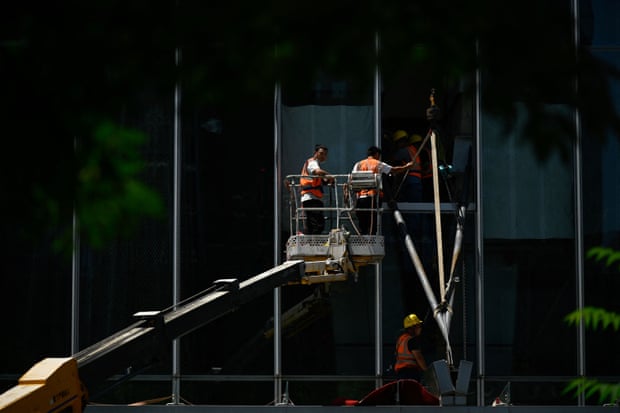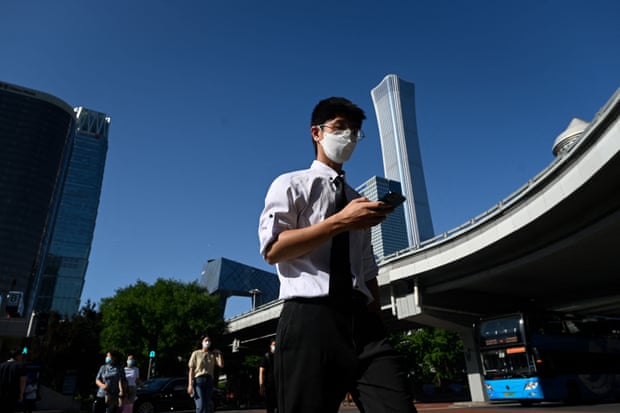China, the world’s second-biggest economy, is in a rocky economic period marked by rolling Covid clampdowns.
The timing is awkward, given China is in the run-up to the 20th National Congress of the Communist party in November, which is expected to extend president Xi Jinping’s grip on power.
But the issues go beyond the pandemic and notably include a deflating property bubble. Here we break down China’s economic outlook – and what it means for Australia and other countries.
How is China faring?
The International Monetary Fund (IMF) last month cut its forecast for China’s 2022 GDP growth by a quarter to 3.3%. That would be the slowest pace in four decades – excluding 2020’s Covid crisis dip – and below the government’s 5.5% target.
In July, almost all the data, from retail sales and manufacturing to investments, missed expectations, says Raymond Yeung, ANZ’s chief economist for greater China.
“My biggest worry is employment,” he says, pointing to the 20% youth unemployment in cities, the highest on record.
Lockdowns to enforce China’s zero-Covid policy aren’t just denting current growth, Yeung said. Future consumption would also be cut, while more young people out of work weakens a prop for China’s property market.
Record heat and the worst drought in decades are also adding to the woes.
Why it matters to Australia (and beyond)
Australia’s economic fortunes are enmeshed with China’s, even as we’re warned its military threat is the worst in decades.
China is easily Australia’s largest two-way trading partner, accounting for about a third of all trade. In June alone, Australia’s exports to China (excluding Hong Kong) topped $16.3bn, or almost double the $8.8bn imports, the Australian Bureau of Statistics says. Trade was about 140 times the level in January 1988, when the data series began.
Prior to Covid, China vied with New Zealand as the top source of short-term visitors, approaching 1.5 million in 2019. It also supplied almost 40% of international students, or about twice India’s share.
China dominates global demand for many raw materials, consuming 70% of the world’s iron ore exports, much of it dug out of the Pilbara.
But China’s coal and oil imports are falling, says Lauri Myllyvirta, lead analyst at the Centre for Research on Energy and Clean Air. “The combination of slowing demand and an energy and resources self-sufficiency drive in China are going to be a double whammy for commodity exporters.”
Property pains mount
Myllyvirta believes China’s drop in cement and steel production in July warrants watching, and aligns with the property slump. “Steel was recovering but is now falling again, which reflects the intense distress in the real estate sector.”
That pain is becoming more evident as developers fail and thousands of mortgage holders refuse to make payments for apartments that may never be built. Graphic images of undated demolitions are also circulating on social media, as are reports of as many as 50m apartments being empty.
The Chinese property market collapse is now so vast and extreme that property companies are demolishing entire cities of half-finished buildings.
— Daniel 💙🇺🇦🏳️🌈✌🏿✌🏽🌿🌍 (@danielrembrandt) August 20, 2022
Ironically, Beijing instigated some of the downturn in a bid to rebalance an economy too dependent on property. The subsequent stalling hit developers such as Evergrande, which defaulted on part of its $US300bn ($A437bn) debt.
S&P Global Ratings last week estimated 40% of developers were in “financial trouble”, with mortgage boycotts posing both social stability and economic risks.
“Should the strikes become widespread, they could undermine financial stability, particularly if they cause a sharp decline in home prices,” said Harry Hu, an S&P analyst.
A July S&P report estimated loans worth as much as 2.4tn yuan ($A500bn) could be affected by the boycotts.
Property bubble with Chinese characteristics
Michael Pettis, a professor of finance at Peking University’s Guanghua School of Management, has long warned about the dangers created by 30 years of rising property prices.
While China’s economy is roughly three-quarters that of the US or Europe, property assets have ballooned to double the size of America’s and triple Europe’s. The result both inflates the sense of wealth in China but also hugely misallocates resources.
Pettis recently noted that developers are yet to deliver about 40% of the homes they sold in advance between 2013 and 2020 – in relatively good times.
“Property developers had historically depended on rising home prices and surging sales to justify massive leverage and overbuilding,” he wrote. “But once the bubble began to deflate last year, these over-leveraged property developers ran into serious liquidity and credit constraints that made it impossible for them to complete their construction projects.”

But while debt binges in the US in the 1920s and Japan in the 1970-80s preceded “calamities”, Beijing’s control over banks and much else in the economy suggests a slowdown rather than collapse, Pettis said.
“Domestic financial conditions are such that China is still unlikely to have a financial crisis or a sharp economic contraction,” he said. “It is much more likely, in my opinion, that the country will face a very long, Japan-style period of low growth.”
He said interest rate cuts, including on Monday, were unlikely to spur much extra borrowing as households and firms were deleveraging rather than taking on more debt.
Big miners remain upbeat – even if iron ore prices are down a third since April. They’re banking on China to build its way out of a slump as it consistently has for decades.
“We expect China to emerge as a source of stability for commodity demand in the year ahead, with policy support progressively taking hold,” BHP’s chief executive Mike Henry said last week.
‘The ageing problem’
Somewhat like Japan, an ageing, even falling Chinese population will add to real estate headwinds and drag on the wider economy.
China’s population may be about to start shrinking if it hasn’t already. That would make it the first contraction since the great famine of the late 1950s, Unravel reported. That publication cited Shanghai Academy of Social Sciences predictions of an annual average decline of 1.1% after 2021.
If that were to continue, China’s population would more than halve from 1.4bn to 587m by 2100.

However, Jane Golley, an economics professor at ANU’s Crawford School of Public Policy, is wary of “collapsists” who have regularly predicted China’s imminent economic demise.
“‘China’s debt bomb looks ready to explode’ – people have been saying it for years,” Golley said. “At some point, it may well happen, but I don’t think it’s going to happen this year just because of the Covid-zero policy”.
Research into China’s scrapped one-child policy indicated a decline in fertility explained between a third and a quarter of China’s per capita income growth in recent decades.
“If you stop having babies, you reduce youth dependency and so you get a surge in the working age population,” Golley said. “That boosts per capita income.”
She said lifting the retirement age, getting more women into the workforce, and raising productivity in poor rural regions “can make significant contributions to offsetting the ageing problem”.
Rather than continuing to hit 8% annual GDP growth rates, China will probably average out at 2-3% in future, Golley said. “Anything above that makes it the world’s largest economy in our lifetime. And that means it’s a force to be reckoned with.”
